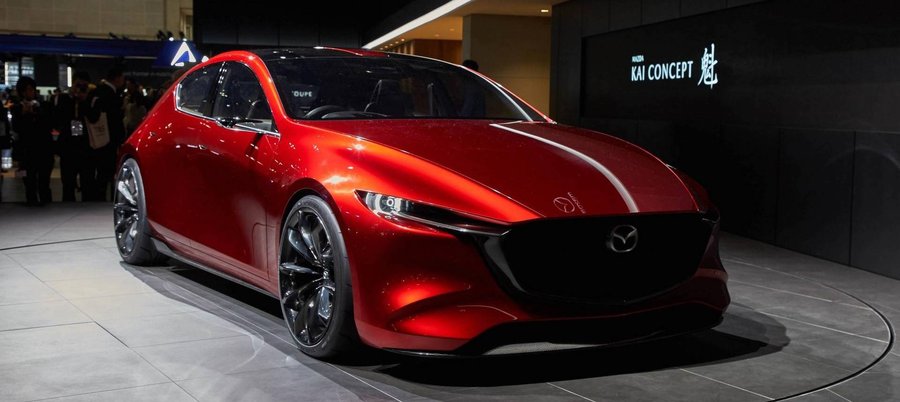Mazda didn't lie — the 2019 Mazda3 is a gently reworked production version of the Kai concept shown at last year's Tokyo Auto Show. In hatchback and sedan forms, you'll still quickly peg this a Mazda3. The dimensions barely change: The wheelbase grows by an inch, but the hatchback width and length carry over, while height decreases by an inch; the sedan is the same width but 3.2 inches longer and 0.7 inches lower. Nevertheless, the look and details have evolved throughout, yielding a much more potent and piercing hatchback, and a more sophisticated, accomplished sedan.
Instead of using hard shoulder and swage lines to "draw" contour onto a flat profile, Mazda designed a car with contours that create real shoulders and hips. Shedding the illusion of surface depth for reality redefines the look and presence of the Mazda3. The new model erases the hash of lines and embossed panels in back of the current car so that the S-curved hatch has only its shutline for framing. After that, the highlights enhance the theme. On either side of the larger grille, single-lens headlamps get new accents; instead of a just plain silver bar, streaks of amber turn signals decorate the more dimensional units. The contoured taillamp housing holds highly structured, highly embellished twin circles that probably look even more sinister at night. On the sedan, those naughty taillights are surrounded by a refined rear valance with a more angled, muscular lip along the trailing edge.
It's the same inside, a design based on results of Mazda's in-depth studies of human mechanics. The flatter instrument panel stresses clean lines along the horizontal. Trimmer steering wheel spokes with silver buttons line up with the central span across the dash housing the climate control buttons and vents. The new shift panel sits higher and more forward, making it easier for the driver to move a hand from the steering wheel to the lever. To raise perceived luxury, the center tunnel trim is a clear layer laid over a laser-engraved black layer, said to produce a "look of deep transparency," and similar to the effect found on the new BMW X5 and X7. The cupholders are now in front of the shifters, and the armrest is longer. There's no mention of that digital gauge cluster that leaked earlier this year, though.
Buyers who opt for fabric will get a new "Greige" hue, a mix of gray and beige. Mazda designed a new leather grain with creases of varying depths and shapes depending on where it's placed. The hatchback offers an exclusive burgundy leather interior, and a Polymetal Gray exterior paint.
The old 7-inch touchscreen atop the IP becomes an 8.8-inch unit with a new menu system for better control. Speakers were moved to produce better sound from the standard eight-speaker and optional 12-speaker Bose audio systems. Speaking of sound, a new two-wall body structure in the floor of the car and fewer holes in the carpeting, plus better sound absorbtion from the headliner and floor mats, calm ambient intrusions.
Other upgrades include seats contoured to hold the body's "S" shape, and tilting seat cushions as standard equipment. Knee airbags come standard, and optional driver assistance features include front cross traffic alert and adaptive cruise control that works in stop-and-go traffic. The driver-side windshield wiper arcs all the way to the thinner A-pillar, and the washer nozzles reside on the wiper arms. An optional driver monitoring feature uses two infrared systems to keep drowsy driving from becoming vehicular homicide. For all who don't like wrenching on their own cars, not only will Mazda Connect provide a digital owner's manual, but warning lights will indicate the priority level of any fault and link directly to the relevant section in the digital owner's manual.
Mazda will offer 1.5-, 2.0-, and 2.5-liter Skyactiv-G gas engines, and the 1.8-liter Skyactiv-D, all with tweaks to improve performance and fuel economy, but it's not clear if the U.S. will get all of them. The fifth option will be the new Skyactiv-X four-cylinder. Yes, a manual transmission stays in the mix. A stiffer body with 10 times more ultra-high-strength steel, and revised suspension improve ride and NVH. The MacPherson strut carries over in front, but some will be disappointed to find that Mazda's eliminated the current rear multilink setup for a torsion beam. Updated tires, the same size as the 16- and 18-inch options currently, provide better damping.
The Japanese carmaker listened to the market, and i-Activ AWD joins the options list, but Mazda didn't say which engines would pair with AWD. The AWD system has been improved with "'four-wheel vertical load' detection," although we're not yet sure how that affects proceedings, and updated brake-based torque vectoring.
Mazda says the 2019 Mazda3 marks the first step in the march toward Mazda Premium. So far, we like it.
Related News

